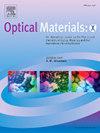Surface mechanics of GaAsP/GaAs epilayers for non-linear optical devices
Q2 Engineering
引用次数: 0
Abstract
We report on nanoindentation measurements of hydride vapor phase epitaxy (HVPE) grown Gallium Arsenide Phosphide (GaAs1-xPx) epilayers, of interest for generation of mid-infrared wavelengths via frequency conversion. Our results indicate a linear trend in Young's modulus with increasing phosphorus content (P-content), in keeping with Vegard's Law for ternary compounds. The corresponding data for hardness demonstrate significant bowing with a peak of 10.7 GPa occurring at 78 % P-content. Some epilayers exhibit non-negligible spatial variation in their mechanical properties, which is investigated with complementary measurements. Photoluminescence measurements indicate high composition uniformity, while atomic force microscopy reveals a direct correlation between surface roughness and mechanical variability. Preliminary laser-induced damage threshold (LIDT) results are reported, and the implications for material optimization are discussed. With a 1070-nm continuous wave laser, GaAs0.75P0.25 and GaAs0.52P0.48 epilayers demonstrated LID thresholds of 600 kW/cm2 and 300 kW/cm2, respectively.
非线性光学器件用GaAsP/GaAs薄膜的表面力学研究
我们报道了氢化物气相外延(HVPE)生长的砷化磷化镓(GaAs1-xPx)薄膜的纳米压痕测量,对通过频率转换产生中红外波长感兴趣。我们的结果表明,杨氏模量随磷含量的增加呈线性趋势,符合三元化合物的维加德定律。相应的硬度数据显示出明显的弯曲,当p含量为78%时,峰值为10.7 GPa。一些脱毛层表现出不可忽略的空间变化在他们的机械性能,这是研究与补充测量。光致发光测量表明高组成均匀性,而原子力显微镜揭示了表面粗糙度和机械变异性之间的直接关系。本文报道了激光诱导损伤阈值(LIDT)的初步结果,并讨论了材料优化的意义。在1070 nm连续波激光下,GaAs0.75P0.25和GaAs0.52P0.48薄膜的LID阈值分别为600 kW/cm2和300 kW/cm2。
本文章由计算机程序翻译,如有差异,请以英文原文为准。
求助全文
约1分钟内获得全文
求助全文
来源期刊

Optical Materials: X
Engineering-Electrical and Electronic Engineering
CiteScore
3.30
自引率
0.00%
发文量
73
审稿时长
91 days
 求助内容:
求助内容: 应助结果提醒方式:
应助结果提醒方式:


